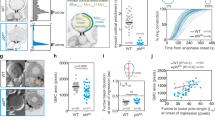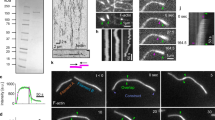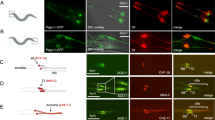Abstract
During mitosis, a ring containing actin and myosin appears beneath the equatorial surface of animal cells. This ring then contracts, forms a cleavage furrow and divides the cell1,2,3, a step known as cytokinesis. The two daughter cells often remain connected by an intercellular bridge which contains a refringent structure known as the midbody4,5. How the appearance of this ring is regulated is unclear, although the small GTPase Rho, which controls the formation of actin structures6,7, is known to be essential8,9,10. Protein kinases are also thought to participate in cytokinesis1,2,3,11,12. We now show that a splice variant of a Rho target protein, named citron13, contains a protein kinase domain that is related to the Rho-associated kinases ROCK14 and ROK15,16,17, which regulate myosin-based contractility18,19,20,21. Citron kinase localizes to the cleavage furrow and midbody of HeLa cells; Rho is also localized in the midbody. We find that overexpression of citron mutants results in the production of multinucleate cells and that a kinase-active mutant causes abnormal contraction during cytokinesis. We propose that citron kinase regulates cytokinesis at a step after Rho in the contractile process.
This is a preview of subscription content, access via your institution
Access options
Subscribe to this journal
Receive 51 print issues and online access
$199.00 per year
only $3.90 per issue
Buy this article
- Purchase on Springer Link
- Instant access to full article PDF
Prices may be subject to local taxes which are calculated during checkout




Similar content being viewed by others
References
Mabuchi, I. Biochemical aspects of cytokinesis. Int. Rev. Cytol. 101, 175–213 (1986).
Satterwhite, L. L. & Pollard, T. D. Cytokinesis. Curr. Opin. Cell Biol. 4, 43–52 (1992).
Fishkind, D. J. & Wang, Y.-L. New horizons for cytokinesis. Curr. Opin. Cell Biol. 7, 23–31 (1995).
Byer, B. & Abramson, D. H. Cytokinesis in HeLa: post-telophase delay and microtubule-associated motility. Protoplasma 66, 413–435 (1968).
Mullins, J. M. & Biesele, J. J. Terminal phase of cytokinesis in D-98S cells. J. Cell Biol. 73, 672–684 (1977).
Machesky, L. M. & Hall, A. Rho: a connection between membrane receptor signalling and the cytoskeleton. Trends Cell Biol. 6, 304–310 (1996).
Narumiya, S. The small GTPase Rho: cellular functions and signal transduction. J. Biochem. (Tokyo) 120, 215–228 (1996).
Mabuchi, I.et al. Arho-like protein is invovled in the organisation of the contractile ring in dividing sand dollar eggs. Zygote 1, 325–331 (1993).
Kishi, K., Sasaki, T., Kuroda, S., Itoh, T. & Takai, Y. Regulation of cytoplasmic division of Xenopus embryo by rho p21 and its inhibitory GDP/GTP exchange protein (rho GDI). J. Cell Biol. 120, 1187–1195 (1993).
Drechsel, D. N., Hyman, A. A., Hall, A. & Glotzer, M. Arequirement for Rho and Cdc42 during cytokinesis in Xenopus embryos. Curr. Biol. 7, 12–23 (1996).
Terada, Y.et al. AIM-1: a mammalian midbody associated protein required for cytokinesis. EMBO J. 17, 667–676 (1998).
Sekimata, M.et al. Detection of protein kinase activity specifically activated at metaphase–anaphase transition. J. Cell Biol. 132, 635–641 (1996).
Madaule, P.et al. Anovel partner for the GTP-bound forms of rho and rac. FEBS Lett. 377, 243–248 (1995).
Ishizaki, T.et al. The small GTP-binding protein Rho binds to and activates a 160?kDa Ser/Thr protein kinase homologous to myotonic dystrophy kinase. EMBO J. 15, 1885–1893 (1996).
Leung, T., Manser, E., Tan, L. & Lim, L. Anovel serine/threonine kinase binding the Ras-related RhoA GTPase which translocates the kinase to peripheral membranes. J. Biol. Chem. 270, 29051–29054 (1995).
Matsui, T.et al. Rho-associated kinase, a novel serine/threonine kinase, as a putative target for the small GTP binding protein Rho. EMBO J. 15, 2208–2216 (1996).
Nakagawa, O.et al. ROCK-I and ROCK-II; two isoforms of Rho-associated coiled-coil forming protein serine/threonine kinase in mice. FEBS Lett. 392, 189–193 (1996).
Ishizaki, T.et al. p160ROCK, a Rho-associated coiled-coil forming protein kinase, works downstream of Rho and induces focal adhesions. FEBS Lett. 404, 118–124 (1997).
Leung, T., Chen, X.-Q., Manser, E. & Lim, L. The p160 RhoA-bindign kinase ROKα is a member of a kinase family and is involved in the reorganization of the cytoskeleton. Mol. Cell. Biol. 16, 5313–5327 (1996).
Kimura, K.et al. Regulation of myosin phosphatase by Rho and Rho-associated kinase (Rho-kinase). Science 273, 245–248 (1996).
Kureishi, Y.et al. Rho-associated kinase directly induces smooth muscle contraction through myosin light chain phosphorylation. J. Biol. Chem. 272, 12257–12260 (1997).
Luo, L.et al. Genghis Khan (Gek) as a putative effector for Drosophila Cdc42 and regulator of actin polymerisation. Proc. Natl Acad. Sci. USA 94, 12963–12968 (1997).
Leung, T., Chen, X.-Q., Tan, I., Manser, E. & Lim, L. Myotonic dystrophy kinase-realted Cdc42-binding kinase acts as a Cdc42 effector in promoting cytoskeletal reorganization. Mol. Cell. Biol. 18, 130–140 (1998).
Watanabe, N.et al. p140mDia, a mammalian homolog of Drosophila diaphanous, is a target protein for Rho small GTPase and is a ligand for profilin. EMBO J. 16, 3044–3056 (1997).
Castrillon, D. & Wasserman, S. diaphanous is required for cytokinesis in Drosophila and shares domains of similarity with the products of the limb deformity gene. Development 120, 3367–3377 (1994).
Uehata, M.et al. Calcium sensitization of smooth muscle mediated by a Rho-associated protein kinase in hypertension. Nature 389, 990–994 (1997).
Niwa, H., Yamamura, K. & Miyazaki, J. Efficient selection for high-expression transfectants with a novel eukaryotic vector. Gene 108, 193–200 (1991).
Andreassen, P., Palmer, D., Wener, M. & Margolis, R. Telophase disc: a new mammalian mitotic organelle that bisects telophase cells with a possible function in cytokinesis. J. Cell Sci. 99, 523–534 (1991).
Acknowledgements
We thank S. Yonemura and I. Mabuchi for critically reading the manuscript and H.A. Popiel for editing it; H. Fuyuhiro and K. Nonomura for technical assistance; and T. Arai, H. Nose and K. Okuyama for secretarial assistance. This work was supported in part by a grant from the Ministry of Education, Sciences, Sports and Culture of Japan and by a grant for the Human Frontier Science Program. P.M. was supported in part by the Ciba–Geigy Foundation.
Author information
Authors and Affiliations
Corresponding author
Supplementary Information
Rights and permissions
About this article
Cite this article
Madaule, P., Eda, M., Watanabe, N. et al. Role of citron kinase as a target of the small GTPase Rho in cytokinesis. Nature 394, 491–494 (1998). https://doi.org/10.1038/28873
Received:
Accepted:
Issue Date:
DOI: https://doi.org/10.1038/28873
This article is cited by
-
TTC3-Mediated Protein Quality Control, A Potential Mechanism for Cognitive Impairment
Cellular and Molecular Neurobiology (2022)
-
MBNL1 reverses the proliferation defect of skeletal muscle satellite cells in myotonic dystrophy type 1 by inhibiting autophagy via the mTOR pathway
Cell Death & Disease (2020)
-
Primary microcephaly with an unstable genome
Genome Instability & Disease (2020)
-
Tissue-specific control of midbody microtubule stability by Citron kinase through modulation of TUBB3 phosphorylation
Cell Death & Differentiation (2016)
-
Mutations in CIT, encoding citron rho-interacting serine/threonine kinase, cause severe primary microcephaly in humans
Human Genetics (2016)
Comments
By submitting a comment you agree to abide by our Terms and Community Guidelines. If you find something abusive or that does not comply with our terms or guidelines please flag it as inappropriate.



